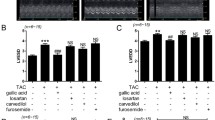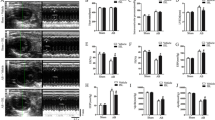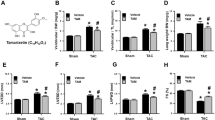Abstract
Cardiac remodelling is a major determinant of heart failure (HF) and is characterised by cardiac hypertrophy, fibrosis, oxidative stress and myocytes apoptosis. Hesperetin, which belongs to the flavonoid subgroup of citrus flavonoids, is the main flavonoid in oranges and possesses multiple pharmacological properties. However, its role in cardiac remodelling remains unknown. We determined the effect of hesperetin on cardiac hypertrophy, fibrosis and heart function using an aortic banding (AB) mouse. Male, 8–10-week-old, wild-type C57 mice with or without oral hesperetin administration were subjected to AB or a sham operation. Our data demonstrated that hesperetin protected against cardiac hypertrophy, fibrosis and dysfunction induced by AB, as assessed by heart weigh/body weight, lung weight/body weight, heart weight/tibia length, echocardiographic and haemodynamic parameters, histological analysis, and gene expression of hypertrophic and fibrotic markers. Also, hesperetin attenuated oxidative stress and myocytes apoptosis induced by AB. The inhibitory effect of hesperetin on cardiac remodelling was mediated by blocking PKCα/βII-AKT, JNK and TGFβ1-Smad signalling pathways. In conclusion, we found that the orange flavonoid hesperetin protected against cardiac remodelling induced by pressure overload via inhibiting cardiac hypertrophy, fibrosis, oxidative stress and myocytes apoptosis. These findings suggest a potential therapeutic drug for cardiac remodelling and HF.




Similar content being viewed by others
References
Antos CL, McKinsey TA, Frey N et al (2002) Activated glycogen synthase-3 beta suppresses cardiac hypertrophy in vivo. Proc Natl Acad Sci USA 99:907–912
Barry SP, Townsend PA (2010) What causes a broken heart–molecular insights into heart failure. Int Rev Cell Mol Biol 284:113–179
Berk BC, Fujiwara K, Lehoux S (2007) ECM remodeling in hypertensive heart disease. J Clin Invest 117:568–575
Bernardo BC, Weeks KL, Pretorius L, McMullen JR (2010) Molecular distinction between physiological and pathological cardiac hypertrophy: experimental findings and therapeutic strategies. Pharmacol Ther 128:191–227
Bisping E, Ikeda S, Kong SW et al (2006) Gata4 is required for maintenance of postnatal cardiac function and protection from pressure overload-induced heart failure. Proc Natl Acad Sci USA 103:14471–14476
Burgoyne JR, Mongue-Din H, Eaton P, Shah AM (2012) Redox signaling in cardiac physiology and pathology. Circ Res 111:1091–1106
Chaanine AH, Jeong D, Liang L et al (2012) JNK modulates FOXO3a for the expression of the mitochondrial death and mitophagy marker BNIP3 in pathological hypertrophy and in heart failure. Cell Death Dis 3:265
DeBosch B, Sambandam N, Weinheimer C, Courtois M, Muslin AJ (2006) Akt2 regulates cardiac metabolism and cardiomyocyte survival. J Biol Chem 281:32841–32851
Deng W, Zong J, Bian Z et al (2013) Indole-3-carbinol protects against pressure overload induced cardiac remodeling via activating AMPK-alpha. Mol Nutr Food Res. doi:10.1002/mnfr.201300012
Fan GC, Yuan Q, Song G et al (2006) Small heat-shock protein Hsp20 attenuates beta-agonist-mediated cardiac remodeling through apoptosis signal-regulating kinase 1. Circ Res 99:1233–1242
Fan X, Turdi S, Ford SP et al (2011) Influence of gestational overfeeding on cardiac morphometry and hypertrophic protein markers in fetal sheep. J Nutr Biochem 22:30–37
Houser SR, Margulies KB, Murphy AM et al (2012) Animal models of heart failure: a scientific statement from the American Heart Association. Circ Res 111:131–150
Keranen LM, Dutil EM, Newton AC (1995) Protein kinase C is regulated in vivo by three functionally distinct phosphorylations. Curr Biol 5:1394–1403
Kim JY, Jung KJ, Choi JS, Chung HY (2006a) Modulation of the age-related nuclear factor-kappaB (NF-kappaB) pathway by hesperetin. Aging Cell 5:401–411
Kim JY, Jung KJ, Choi JS, Chung HY (2006b) Modulation of the age-related nuclear factor-kappaB (NF-kappaB) pathway by hesperetin. Aging Cell 5:401–411
Li HL, Wang AB, Huang Y et al (2005) Isorhapontigenin, a new resveratrol analog, attenuates cardiac hypertrophy via blocking signaling transduction pathways. Free Radic Biol Med 38:243–257
Li P, Wang D, Lucas J et al (2008) Atrial natriuretic peptide inhibits transforming growth factor beta-induced Smad signaling and myofibroblast transformation in mouse cardiac fibroblasts. Circ Res 102:185–192
Liang Q, Molkentin JD (2003) Redefining the roles of p38 and JNK signaling in cardiac hypertrophy: dichotomy between cultured myocytes and animal models. J Mol Cell Cardiol 35:1385–1394
McMullen JR, Sherwood MC, Tarnavski O et al (2004) Inhibition of mTOR signaling with rapamycin regresses established cardiac hypertrophy induced by pressure overload. Circulation 109:3050–3055
Morin B, Nichols LA, Zalasky KM, Davis JW, Manthey JA, Holland LJ (2008) The citrus flavonoids hesperetin and nobiletin differentially regulate low density lipoprotein receptor gene transcription in HepG2 liver cells. J Nutr 138:1274–1281
Ni YG, Berenji K, Wang N et al (2006) Foxo transcription factors blunt cardiac hypertrophy by inhibiting calcineurin signaling. Circulation 114:1159–1168
Octavia Y, Brunner-La RHP, Moens AL (2012) NADPH oxidase-dependent oxidative stress in the failing heart: from pathogenic roles to therapeutic approach. Free Radic Biol Med 52:291–297
Palfi A, Toth A, Hanto K et al (2006) PARP inhibition prevents postinfarction myocardial remodeling and heart failure via the protein kinase C/glycogen synthase kinase-3beta pathway. J Mol Cell Cardiol 41:149–159
Pari L, Shagirtha K (2012) Hesperetin protects against oxidative stress related hepatic dysfunction by cadmium in rats. Exp Toxicol Pathol 64:513–520
Sabri A, Steinberg SF (2003) Protein kinase C isoform-selective signals that lead to cardiac hypertrophy and the progression of heart failure. Mol Cell Biochem 251:97–101
Scholz EP, Zitron E, Kiesecker C et al (2007) Orange flavonoid hesperetin modulates cardiac hERG potassium channel via binding to amino acid F656. Nutr Metab Cardiovasc Dis 17:666–675
Shah AM, Mann DL (2011) In search of new therapeutic targets and strategies for heart failure: recent advances in basic science. Lancet 378:704–712
Shih CH, Lin LH, Hsu HT et al (2012) Hesperetin, a selective phosphodiesterase 4 inhibitor, effectively suppresses ovalbumin-induced airway hyperresponsiveness without influencing xylazine/ketamine-induced anesthesia. Evid Based Complement Alternat Med 2012:472897
Singh SS, Kang PM (2011) Mechanisms and inhibitors of apoptosis in cardiovascular diseases. Curr Pharm Des 17:1783–1793
Skurk C, Izumiya Y, Maatz H et al (2005) The FOXO3a transcription factor regulates cardiac myocyte size downstream of AKT signaling. J Biol Chem 280:20814–20823
Soesanto W, Lin HY, Hu E et al (2009) Mammalian target of rapamycin is a critical regulator of cardiac hypertrophy in spontaneously hypertensive rats. Hypertension 54:1321–1327
Trivedi PP, Kushwaha S, Tripathi DN, Jena GB (2011) Cardioprotective effects of hesperetin against doxorubicin-induced oxidative stress and DNA damage in rat. Cardiovasc Toxicol 11:215–225
Wang N, Guan P, Zhang JP et al (2011) Fasudil hydrochloride hydrate, a Rho-kinase inhibitor, suppresses isoproterenol-induced heart failure in rats via JNK and ERK1/2 pathways. J Cell Biochem 112:1920–1929
Wong WW, Puthalakath H (2008) Bcl-2 family proteins: the sentinels of the mitochondrial apoptosis pathway. IUBMB Life 60:390–397
Yan L, Huang H, Tang QZ et al (2010) Breviscapine protects against cardiac hypertrophy through blocking PKC-alpha-dependent signaling. J Cell Biochem 109:1158–1171
Yang HL, Chen SC, Senthil KKJ et al (2012) Antioxidant and anti-inflammatory potential of hesperetin metabolites obtained from hesperetin-administered rat serum: an ex vivo approach. J Agric Food Chem 60:522–532
Ye L, Chan FL, Chen S, Leung LK (2012) The citrus flavonone hesperetin inhibits growth of aromatase-expressing MCF-7 tumor in ovariectomized athymic mice. J Nutr Biochem 23:1230–1237
Yoshida H, Takamura N, Shuto T et al (2010) The citrus flavonoids hesperetin and naringenin block the lipolytic actions of TNF-alpha in mouse adipocytes. Biochem Biophys Res Commun 394:728–732
Zong J, Deng W, Zhou H et al (2013) 3,3′-Diindolylmethane Protects against Cardiac Hypertrophy via 5′-Adenosine Monophosphate-Activated Protein Kinase-alpha2. PLoS One 8:e53427
Acknowledgments
This work was supported by the National Nature Science Foundation of China [81270303]; and the Fundamental Research Funds for the Central Universities of China [20103020201000193].
Conflict of interest
The authors have no any potential conflicts of interest.
Author information
Authors and Affiliations
Corresponding author
Additional information
Wei Deng and Duan Jiang contributed equally to this work.
Rights and permissions
About this article
Cite this article
Deng, W., Jiang, D., Fang, Y. et al. Hesperetin protects against cardiac remodelling induced by pressure overload in mice. J Mol Hist 44, 575–585 (2013). https://doi.org/10.1007/s10735-013-9514-7
Received:
Accepted:
Published:
Issue Date:
DOI: https://doi.org/10.1007/s10735-013-9514-7




